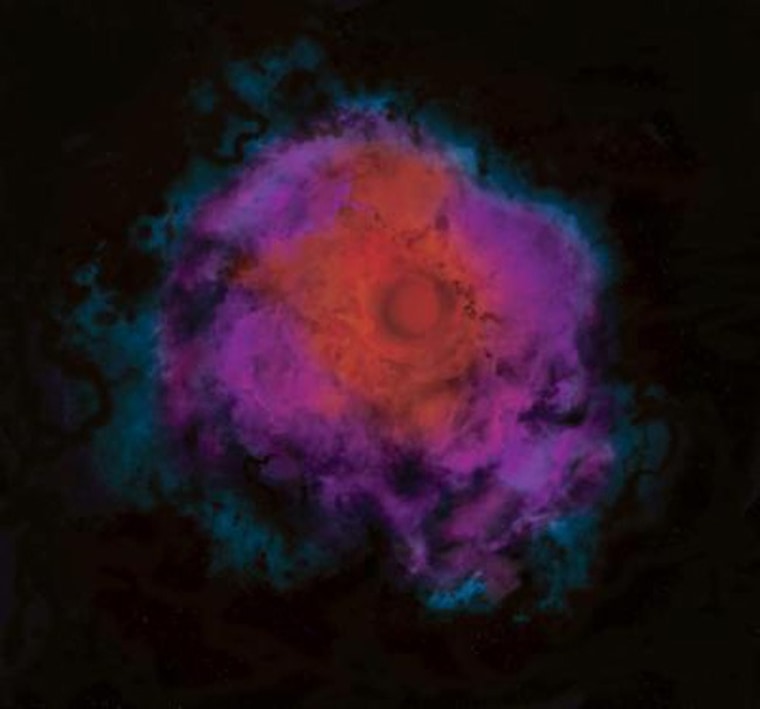When the very first stars lit up, they may have been fueled by the dark matter that has long eluded scientists.
These "dark stars," first born nearly 13 billion years ago, might still exist today. Although they would not shed any visible light, astronomers might detect these invisible giants — some 400 to 200,000 times wider than our sun and 500 to 1,000 times more massive — because they should spew gamma rays, neutrinos and antimatter and be linked with clouds of cold, molecular hydrogen gas that normally would not harbor such energetic particles.
If scientists find these stars, they could aid the search to discover and identify dark matter. They could also help solve the mystery of why black holes formed much faster than expected.
Scientists think unseen, as-yet unidentified dark matter makes up about 95 percent of all matter in the universe. They know it exists because galaxies rotate faster than can be explained by the visible matter within them.
Among the main candidates for what dark matter is are WIMPs, or weakly interacting massive particles. One type of WIMP that scientists theorize exists is called a neutralino. These particle can annihilate each other, generating heat. They would also produce quarks and their antimatter counterparts, antiquarks, which would collide to emit gamma rays, neutrinos and antimatter such as positrons and antiprotons.
The researchers calculated that in the newborn universe, some 80 to 100 million years after the big bang, as proto-stellar clouds of hydrogen and helium tried to cool and shrink, annihilating neutralinos would have kept them hot and large. The result might be dark stars, fueled by dark matter instead of nuclear energy as in normal stars. These would have been made up largely of normal matter, mostly in the form of hydrogen and helium, but would be vastly larger and fluffier than the sun and current stars.
"It's a completely new type of star with a new power source," said researcher Katherine Freese, a theoretical physicist at the University of Michigan.
Originally researcher Paolo Gondolo, a particle astrophysicist at the University of Utah, wanted to dub these new, theoretical kinds of invisible stars "brown giants," similar to dim but smaller, Jupiter-sized stars known as "brown dwarfs." But he said his collaborators insisted on calling them "dark stars," after the song "Dark Star" first played in 1967 by the revered rock band The Grateful Dead. "There is a dark star song by Crosby, Stills, Nash and Young, too, that we had in mind," Freese said.
"It was a good name," Gondolo noted.
Although dark stars are made up of less than 1 percent dark matter, "it's very important," he explained. "It converts all of its mass to energy with 100 percent efficiency, under Einstein's equation, E=mc2. Normal stars that rely on nuclear energy convert just a small fraction of its mass to energy, 1 or 2 percent."
There was initially skepticism as to whether dark matter densities were high enough in the early universe to support the creation of dark stars. "However, we've checked it and so have two other groups, and they agree with us," Freese said.
Dark stars could be detected with the next-generation James Webb Space Telescope currently scheduled for launch in 2014. "It may be that these stars eventually cluster together, and clusters of them might be visible with the James Webb Space Telescope," Gondolo said.
If scientists do discover dark stars, "they would tell us a very important thing — that dark matter is made of elementary particles," Gondolo said. "At this moment, we know absolutely nothing about what dark matter is made of. We know where dark matter is, how much is there, but we don't know its nature."
Dark stars might also explain why black holes formed much faster than expected. Astronomers have found black holes that existed only a few hundred million years after the Big Bang, yet current theories suggest they should have taken longer to form. Dark stars might have collapsed into black holes very early, Gondolo said, because they might be very short-lived and could have formed when the universe was young.
In addition, dark stars could solve a puzzle seen with stars in the galactic halo, the murky, roughly spherical part of the galaxy extending past the main, visible component. "There's an abundance of elements in the very old halo stars that's hard to explain, and dark stars can explain that — they would end up creating the chemical abundances needed," Gondolo said.
It is unlikely any dark stars are being formed today, Freese said.
"The early universe was more compact than it is now, and everything was denser, including the amount of dark matter one had at any one place," she explained. "Now the universe has expanded and things are less dense, making it harder to make dark stars today."
It remains uncertain just how long dark stars might live, Freese said.
"The ones that formed in the early universe could have continued as long as they had dark matter to power them," Freese said. "They start at the center of dark matter 'halos' — giant spherical globes of dark matter — and these are always merging with other ones, so some might have burned out their dark matter fuel very early and become either normal stars or collapsed, but it remains an open question if any have survived until now."
